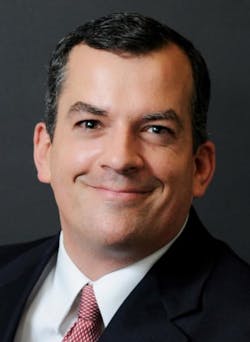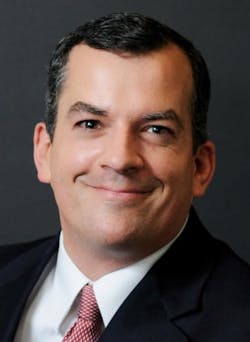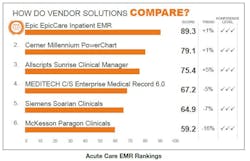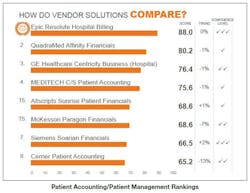The “Best in KLAS 2014 Software & Services” report, released recently by the Orem, Utah-based KLAS Research, comes at a time when broad policy and business trends in healthcare are strongly affecting the healthcare IT industry. Most notably, intense efforts on the part of providers to engage in population health and accountable care arrangements are changing the landscape for core electronic health record/electronic medical record (EHR/EMR) vendors, while the need to interoperate between clinical and financial systems—coming out of the same trends around the shift towards population health and accountable care on the part of providers—is rearranging the landscape for vendors offering patient accounting and revenue cycle management solutions.
In that context, HCI Editor-in-Chief Mark Hagland interviewed Colin Buckley, director of research strategy at KLAS, on the EHR/EMR vendor segment results from this year’s “Best In KLAS” report, and interviewed Boyd Stewart, a research director on KLAS’s professional services and financial solutions team, to get their perspectives in those areas. Below are excerpts from both interviews.
Colin Buckley
When It Comes to EMR/EHR, Population Health Is Forcing Shifts
What do you see as some of the biggest trends right now in the EMR/EHR vendor space?
Colin Buckley: In some ways, the story hasn’t changed dramatically from previous years, though some vendors are struggling more than others. In terms of the major vendors on the acute-care side, we have Epic and Cerner still leading the pack, due to the integration, the more consistent service and delivery, as well as the hand-holding and knowledge and expertise, that they offer; then we’ve got Meditech and McKesson Paragon as two vendors not being considered nearly as much by healthcare IT executives as Cerner and Epic, and their performance has been uneven as well. Now, Allscripts in the anomaly; that’s the one that really sticks out this year, that Allscripts had a pretty significant improvement in their score; and they had a significant improvement last year, too. We’re hearing from their customers that they’re pleased with how things have been going, with their strategy and acquisitions.
And we just put online today a report, the EMR Purchasing Plans Report, and for those who are switching, most of the consideration is still going to Epic and Cerner; Allscripts gets very little consideration from the outside. But the stability of their customer base has increased, and two-thirds of the folks currently on Allscripts told us they’re definitely staying put. They’ve become optimistic; they’ve seen improvements in the Sunrise enterprise suite. So Allscripts was third place this year, and that derives from satisfaction with the suite of products that used to be the old Eclipsys suite. They’ve been maturing that product, and the satisfaction with it has slowed down attrition from Allscripts, but hasn’t compelled most newcomers to consider it.
How will the competition for new contracts play out?
Based on the research we did for this new report, Epic and Cerner are still getting the bulk of the attention. Meanwhile, what will happen with the legacy EMR organizations—Meditech CS, and Meditech Magic? A lot of their customers are looking to upgrade to the latest Version 6, and they’re headed in that direction. Version 6 is a new platform, so upgrading to Version 6 is really like doing a new implementation. But most of Meditech’s customers are remaining loyal. Meanwhile, one of the biggest trouble spots has been around Paragon by McKesson, which has dropped, as they’ve struggled to deliver reliable upgrades.
Do you see overall satisfaction improving among vendors?
I don’t think so. There may be a bit of leveling out happening. The distribution is probably spreading a bit.
Has the EMR market matured? Have the products matured? Or is that too general?
The products are better than they used to be, and most are improving to some degree or another. The question is, can the vendors keep up with the expectations that keep changing all the time.
How has the meaningful use program impacted all of this? It appears to have made healthcare IT executives impatient with the pace of innovation on the part of core EMR/EHR vendors.
Yes, it’s raising the bar all the time. meaningful use Stage 1 revolutionized the market. And now the expectations are far beyond just implementing a system and turning it on. And they’re being asked to do things that are much more impactful. And even when some vendors are having some challenges, that is a form of maturation.
We’re hearing about dissatisfaction with EHR capabilities overall.
There is a lot of that, and a lot of providers are anxious with demands facing them, even if they’re not today’s demands, and they don’t see vendors meeting those demands. Last year, we did a perception study, and randomly called up providers and asked them questions. And one question we asked them was, if they were doing population health, what vendors they used today and what vendors they might be using. We asked which vendors were playing a role for them. And the most-often-mentioned vendor they said was playing a role and would do so in the future, were the EMR vendors. So I think there is a hope and an expectation that those EMR vendors will mature towards fulfilling expectations.
What’s interesting is the diverse strategies of the top EMR vendors. Epic has been adding more functionality to its Healthy Planet population health module, while Cerner is putting together an entirely new population health platform, Healthy Intent, which is intended to be vendor-agnostic. I don’t see best-of-breed population health solutions going away, but pieces of population health will be integrated into EMRs. And that makes sense, because ideally, for example, you wouldn’t want to have to force a physician to go into a separate product just to check in about a patient who had a cold. And that’s the benefit of an integrated core system. And some of the functionalities now in the best-of-breed products will migrate into the core EMR products over time. Still, in the case of Cerner, they’re almost created a best-of-breed product being offered by a core EMR vendor. And of course, Allscripts acquired dbMotion; and Allscripts’ customers saw that as a smart move.
With regard to patient accounting and revenue cycle management solutions, a core component of business software for virtually all hospital-based organizations, Boyd Stewart, a research director who is on the professional services and financial team at KLAS Research, seems significant shifts taking place based on the need for interoperability and integration between clinical and financial information systems. Below are excerpts from his recent interview with HCI Editor-in-Chief Mark Hagland.
Boyd Stewart
How are CIOs and other IT executives feeling about the Patient Accounting and Patient Management category, which encompasses revenue cycle offerings, these days?
At the 50,000-feet-up level, we’re seeing decisions around clinical IT selection driving the decisions around revenue cycle solution selection. The biggest question these days for providers is whether they should consider driving their organizations broadly towards single-source strategies on both sides of the divide—in other words, whether they should try to get their clinical and financial software from the same core vendors. When you look at the chart related to the top vendors in this area [see below], you’ll see some vendors that offer integrated packages, and others that don’t. If you were extremely desirous of getting a GE or QuadraMed clinical solution to interface with those companies’ offerings on the financial side, they could probably help you somehow; but essentially, those two are best-of-breed solutions, and best-of-breed is not the main strategy these days.
The customers of both GE and QuadraMed are expressing satisfaction and telling us that those companies have been investing a lot in the functionality of their solutions. GE is usually chosen because their financial product is integrated across the inpatient and ambulatory spheres. That’s not true of QuadraMed, but they still have a base of customers who are loyal to them.
So more people will end up going with patient accounting and revenue cycle solutions offered by core EHR [electronic health record] vendors as well?
Yes. And Cerner is high up in terms of choice, in that regard. Meanwhile, the Cerner acquisition of Siemens is causing a lot of people to question whether they should stay with Siemens Soarian Financials, even as Cerner has promised that they would service Soarian Financials for 10 years. So, people are taking a wait-and-see attitude to see what happens. With regard to Cerner itself, Cerner has a strong clinical information system with high satisfaction levels; nonetheless, we’ve talked to CIOs at several organizations who are still waiting for that company’s patient accounting piece to mature more so they feel comfortable getting it.
We spoke recently with a hospital CIO, who shared with us about a conversation he had with his CFO. That CIO reported to us that his CFO expressed the sentiment that the risk of getting an immature financials system is a higher risk than that of getting an integrated clinical and financial system at a high price. That organization is currently a Cerner clinical customer, and its executives are very happy with that side, but are considering Epic for everything because of the integration factor; they want a mature, stable patient accounting system, and want to keep that enterprise view. We’ve seen the senior executives at a few organizations talk that way.
So it seems clear that many healthcare executives are strategizing towards acquiring integrated systems combining the clinical and financial sides. Do you have any other broad predictions?
It’s interesting, as we’ve seen the implementations on the clinical side take place, we’re starting to get asked a lot more by providers the question, who can help me optimize my clinical systems? And a lot of work is going on, on the revenue cycle side, too. A lot of providers are still on legacy revenue cycle systems. And they’re starting to see that they’ve got to optimize and make things flow better. And a lot of that flow is interoperating between the clinical and financial sides.






